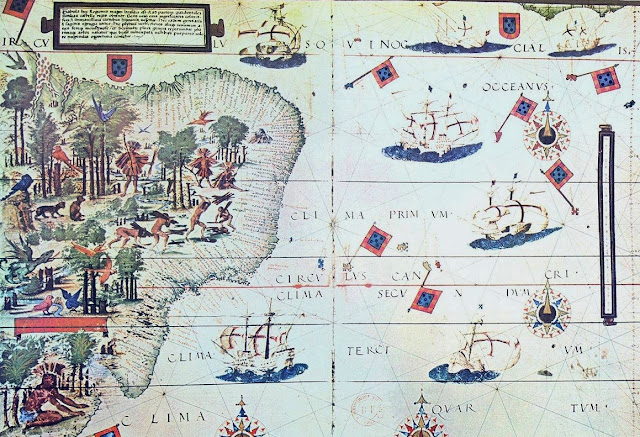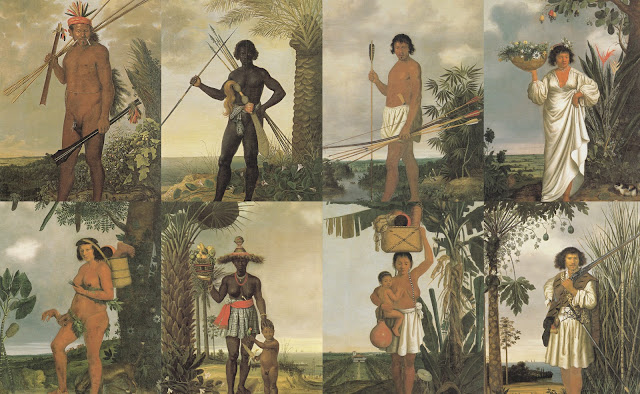Brazilian History: The Power of Go Betweens
https://phistars.blogspot.com/2012/12/brazilian-history-power-of-go-betweens.html
Editor's Note: Sometime has passed, thus, I decided to post my homework on my blog. You know, for pharmaceutical purposes. It was a good essay. It got an A plus. Thus, even my teacher thought my homework was 5 stars worthy. Oh, I am going add a few pictures that relate to my essay. You know, something help you visualize what I am talking about.
Brazilian History: The
Power of Go Betweens
In Colonial Brazil, there was a power struggle between Jesuits
and the Colonist. Each had their own methods of handling the Indians. The Jesuits wanted to keep the Indians in
missions. There they lived relative autonomous life under the guiding hand of
the church. The colonist simply wanted to enslave the Indians. They did not
care much for the Evangelization of the Indians. All that mattered to the
colonist was the increasing revenues.
Well, both methods required go betweens that negotiated
with the Indians. The Jesuits needed them for convincing the Indians to enter
missions. The colonist used them go betweens in order to use other Indians to
collect the slaves for them. In both cases, it was the go betweens that
benefited from the rivalry between the Church and the colonist. For this
reason, the go betweens where seen as a necessary evil. Their ambiguous lifestyle made them a treat to
the institutions of Portuguese society and the Evangelization missions of the
Catholic Church.
In the readings of Metcalf, there appear two types of go
betweens. Dominges Fernandes Nobre or Tomacauna was a go between the colonists
and the Indians[i].
The Lisbon Inquisitor that was sent by the Portuguese crown was a go between
the colonist and the Catholic Church[ii]. Each had their own agenda. Thus, the actions
of Tomacuana benefited the colonist sugar planters. Meanwhile, the Inquisitor
favored the Evangelist mission of the Jesuits and the church. Thus, each was
advancing a different model of colonization.
The sugar planter’s model of colonization consisted on
slave driven labor. Little attention was paid to the Evangelization of the
slave labor. The Amerindian Indians was the closet source of man power. The
Jesuits had managed to make illegal the enslavement of Indians. Still, it was
noted that those regulations where rarely enforced[iii].
Plus, many Indian slaves did not survive their captivity. Thus, their
population was seriously dropping.
The model of the church model of colonization focused on
missions. Basically, the Jesuits or other priestly ordered created a town of
Indians. In this town, the Indians worked for the priest. Aside from work, the
Indians obtained education in both Catholics and European practices. Via this
method, the Indians where slowly integrated into the Portuguese society.
Integration did not benefit the planters. The time spent learning was a time
the Indians did not spend working. Thus, to evangelize it became necessary to
keep the Indians away from the regular sugar planters. This separation was also meant to keep the
pure from the negative influence from the Portuguese. By the time, the Lisbon Inquisitor
had arrived; many moral irregularities were taking place in Brazil[iv]. Thus,
the Lisbon Inquisitor’s presence tipped the scale in favor of the Jesuits and
the other missionary orders.
Tomacuana had gotten in trouble with the Inquisition
because of his go between methods. His actions did not promote the Evangelization
of the Indians. Rather, they helped perpetuate their heretical practices. For
the Jesuits, men like Tomacuana also helped perpetuate the illegal enslavement
of the Indians[v].
Plus, the fact that Tomacuana engaged in
pagan rituals was unacceptable[vi].
In Metcaft “Power”
reading, the Lisbon Inquisitor wrote a decree that punished those who lived
sinful lives. Those that confessed their sins and the sins of people they knew
got to keep their estates[vii].
What was considered sinful was any
practice or behavior that did not match the mores of a Catholic Portuguese
country. Naturally, someone like Tomacuana became a target under this decree. Many
of those that confessed implicated Fernandes Nobre as a follower of the
heretical “Santidade” Indian religion. His wife too accused him of tattooing
himself. Thus, the charges brought against Fernandes Nobre had nothing to do
with his line of work. Rather, the methods that he used to obtain slave labor
were seen as sinful by society.
Based on the list of sins posted by the Lisbon
Inquisitor, it seems that Fernandes Nobre was guilty of adopting Indigenous
practices while living in the Colony[viii].
Metcalf believes that the Jesuits
convinced the Inquisition of making this a sin in order to get rid of the “mamelucos”
like Fernandes Nobre[ix].
The mamelucos were half native, half Portuguese. Their native mothers had
taught their language and culture. They had the advantage of being able to live
in both the Native and Portuguese world. The way they worked was very similar
to the Jesuits. Both became fully integrated into an Indian clan. The Jesuits
too learned the language and culture of the Natives. However, their aim was to
establish missions. The mamelucos, on the other hand, manipulated the Indians
into getting other Indian slaves for the sugar planters.
Obviously, these mamelucos interfered with the Jesuit
missions. It was noted that many of the denunciations against the mamelucos
where put forth by Jesuit priest[x]. They saw their opportunity to get rid of
their competition with the arrival of the Lisbon Inquisitor. By getting rid of
them, the sugar planters would lose their means of obtaining Indian slave
workers. In Metcalf “Domingos Fernandes Nobre”, shows how mamelucos obtained
Indian labor for the planters. Aside from knowing the languages and culture,
Fernandes Nobre had tattooed himself. In doing so, he showed the Indians he was
a brave warrior. This earned him the nickname Tomacuana. By earning their
trust, Fernandes Nobre traded weapons for slaves[xi]. These slaves were usually people from enemy
tribes.
In his last mission, Fernandes Nobre was dealing with a
tribe whose worship was called “Santidades”. This sect was seen dangerous because
it predicted the coming of a being who would free all under the yoke of
oppression. This naturally appealed to a lot of slaves. Many escaped to join
the “Santidade” group[xii].
Thus, it did not bode well for Fernandes Nobre to participate in a sect that was
both heretical and that caused slaves to escape their masters. Another problem
was that Santidade also drew in a large following of mamelucos. It makes sense
that those who followed Fernandes Nobre wondered if he truly believed in the
rituals of the Santidade. These suspicions were due to Fernandes Nobre’s
mamelucos heritage. For this reason, many who accused Fernandes Nobre to the
Inquisition had been part of his expeditions to the Santidade[xiii].
In the end, all these accusations were only a means to an
end. Fernandes Nobre could only obtain forgiveness by foregoing all of his
Native practices. He had to assimilate completely into the Portuguese society[xiv].
With this forced assimilation, Fernandes
Nobre lost his ability to serve as a go between. He could no longer gain the
confidence of the Natives like before. Thus, via this method, the Jesuits made
it harder for the mamelucos to excerpt their influence over the natives. Seeing
the attention given to the mamelucos, it is obvious that they had great power
in the colony. They alone made things harder for the Jesuits to advance their
colonization model. The only way for the church to combat them was to make a sin
the methods the mamelucos employed in their line of work. The visit of the
Lisbon Inquisitor gave the Jesuits the chance they needed to get rid of their
competition.
[i]
Alida C. Metcalf, “Domingos Fernandes Nobre” Pg 52
[ii]
Alida C. Metcalf, “Power” Pg 2
[iii]
Metcaft, “Power” Pg 4 or Pg 239
[iv]
Metcaft, “Domingos Fernandez Nobre” pg 60
[v]
Metcaft, “Power” Pg 3
[vi]
Metcaft, “Domingos Fernandez Nobre” pg 60
[vii]
Metcaft, “Power” Pg 4 or Pg 239
[viii]
Metcaft, “Power” Pg 4 or Pg 239
[ix]
Metcaft, “Power” Pg 241
[x]
Metcaft, “Power” Pg 241
[xi]
Metcaft, “Domingos Fernandez Nobre” pg 55
[xii]
Metcaft, “Domingos Fernandez Nobre” pg 57
[xiii]
Metcaft, “Domingos Fernandez Nobre” pg 56
+Colonial+Brazil+depiction+of+the+Natives+eating+a+misionary.jpg)






